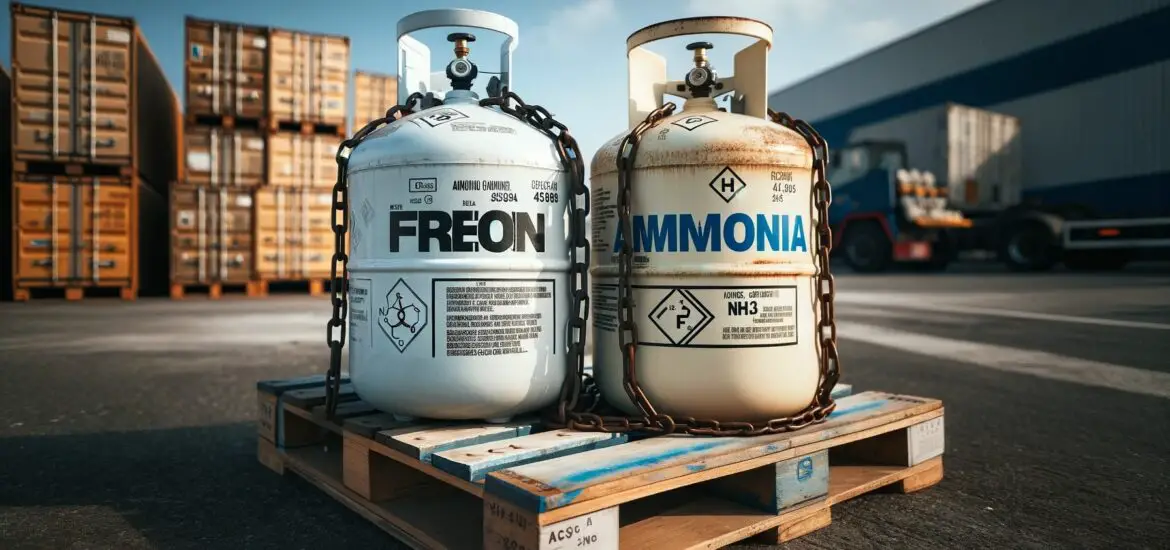When selecting a refrigerant for cooling systems, understanding the difference between Freon and ammonia is pivotal. This guide aims to break down these differences in a manner that is easy to understand, even for those new to refrigeration concepts.

Table of Contents
What Is Freon?
Freon is not a single chemical but a brand name for a family of refrigerants manufactured by the Chemours Company. These refrigerants are halocarbons, which include various types of CFCs, HCFCs, and HFCs.
These compounds are made up of carbon, chlorine, fluorine, and sometimes hydrogen. Their molecular stability allows them to move from gas to liquid and back again at convenient temperatures for refrigeration cycles.
For example, Freon-12 (dichlorodifluoromethane), one of the most common CFCs, is used in older refrigeration systems and air conditioners. It is known for its non-flammability and low toxicity, but it has been phased out due to its ozone-depleting potential.
Alternatives, like HFCs (such as R-134a), do not deplete the ozone but still contribute to greenhouse gas effects.
What Is Ammonia?
Ammonia (NH3) is a naturally occurring compound made of nitrogen and hydrogen. In the context of refrigeration, ammonia serves as an efficient refrigerant due to its thermodynamic properties. It absorbs a large amount of heat from its surroundings when it evaporates, making it highly effective for cooling purposes.
While it’s known for its pungent odor, it is also recognized for its eco-friendliness and energy efficiency. Ammonia has been used as a refrigerant for over a century and is especially prevalent in large industrial refrigeration systems due to its effectiveness and low cost.
Difference Between Freon and Ammonia
Now that we’ve met the two contenders, let’s place them side by side as we reveal the difference between Freon and Ammonia.
Comparing the Physical Properties
The physical properties of Freon and ammonia are what define their suitability for different refrigeration needs.
Freons generally have higher boiling points compared to ammonia. This means that at atmospheric pressure, Freons convert from liquid to gas at higher temperatures, which can be less efficient in systems that require colder temperatures.
Ammonia, with a boiling point of -33.34°C, is effective in a wider range of temperatures and can provide cooling at much lower temperatures than Freon. It also has a high latent heat capacity, which means it can absorb more heat while changing from liquid to gas. This property makes ammonia a more efficient refrigerant, requiring less energy to achieve the same cooling effect as Freon.
Environmental Impact
Environmental impact is a significant difference between Freon and ammonia.
Freon compounds, particularly CFCs and HCFCs, have been known to contribute to ozone layer depletion. The ozone layer is crucial for protecting the Earth from the sun’s harmful ultraviolet radiation.
The phasing out of these substances under international agreements like the Montreal Protocol has been a critical step in environmental protection. HFCs, while better for the ozone layer, are potent greenhouse gases that contribute to global warming.
Ammonia, on the other hand, does not deplete the ozone layer nor does it have a significant greenhouse effect, making it an environmentally favorable choice. Its impact is minimal when compared to that of various Freon compounds, thereby offering a greener alternative for large-scale refrigeration systems.
Safety and Health Considerations
Safety and health considerations are paramount when handling these refrigerants.
Freon is generally safer to handle due to its low toxicity and non-flammability under normal conditions. However, when exposed to high temperatures, Freons can decompose and form toxic substances such as hydrochloric acid and phosgene gas.
Ammonia poses higher health risks due to its toxicity. It is corrosive, and exposure can irritate the skin, eyes, and respiratory tract. In high concentrations, ammonia can be fatal. As such, stringent safety protocols are in place for handling and storing ammonia, including the requirement of specialized equipment and training for personnel who work with it.
Applications
Another difference between Freon and ammonia is the applications of these refrigerants and this is based on their properties.
Freon has traditionally been used in residential and automotive air conditioning systems, commercial refrigerators, and HVAC systems. Its ease of handling and safety profile make it suitable for environments where human exposure is likely.
Ammonia’s superior cooling efficiency lends itself to larger, industrial refrigeration systems. It is commonly found in food processing facilities, cold storage warehouses, and plants requiring substantial cooling capabilities. Despite its efficiency benefits, ammonia’s toxicity restricts its use to environments where strict safety measures can be implemented.
By now, we believe you have a clearer picture of the difference between Freon and ammonia and their respective places in the world of refrigeration. Whether you’re making a decision for environmental reasons, cost considerations, or system efficiency, knowing these key differences is essential in selecting the right refrigerant for your needs.